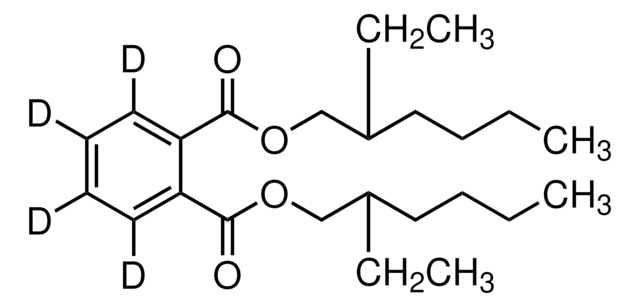V800149
Dibutyl phthalate
AR, ≥99%
Synonym(s):
n-Butyl phthalate, DBP, Phthalic acid dibutyl ester
About This Item
Recommended Products
grade
AR
vapor density
9.6 (vs air)
vapor pressure
1 mmHg ( 147 °C)
product line
Vetec™
Assay
≥99%
form
liquid
autoignition temp.
756 °F
expl. lim.
0.47 %, 236 °F
refractive index
n20/D 1.492 (lit.)
pH
7 (20 °C, 10 mg/L)
bp
340 °C (lit.)
mp
−35 °C (lit.)
density
1.043 g/mL at 25 °C (lit.)
functional group
ester
SMILES string
CCCCOC(=O)c1ccccc1C(=O)OCCCC
InChI
1S/C16H22O4/c1-3-5-11-19-15(17)13-9-7-8-10-14(13)16(18)20-12-6-4-2/h7-10H,3-6,11-12H2,1-2H3
InChI key
DOIRQSBPFJWKBE-UHFFFAOYSA-N
Looking for similar products? Visit Product Comparison Guide
Application
Legal Information
Signal Word
Danger
Hazard Statements
Precautionary Statements
Hazard Classifications
Aquatic Acute 1 - Aquatic Chronic 2 - Repr. 1B
Storage Class Code
6.1C - Combustible acute toxic Cat.3 / toxic compounds or compounds which causing chronic effects
WGK
WGK 3
Flash Point(F)
367.7 °F - open cup
Flash Point(C)
186.5 °C - open cup
Choose from one of the most recent versions:
Certificates of Analysis (COA)
Sorry, we don't have COAs for this product available online at this time.
If you need assistance, please contact Customer Support.
Already Own This Product?
Find documentation for the products that you have recently purchased in the Document Library.
Our team of scientists has experience in all areas of research including Life Science, Material Science, Chemical Synthesis, Chromatography, Analytical and many others.
Contact Technical Service





